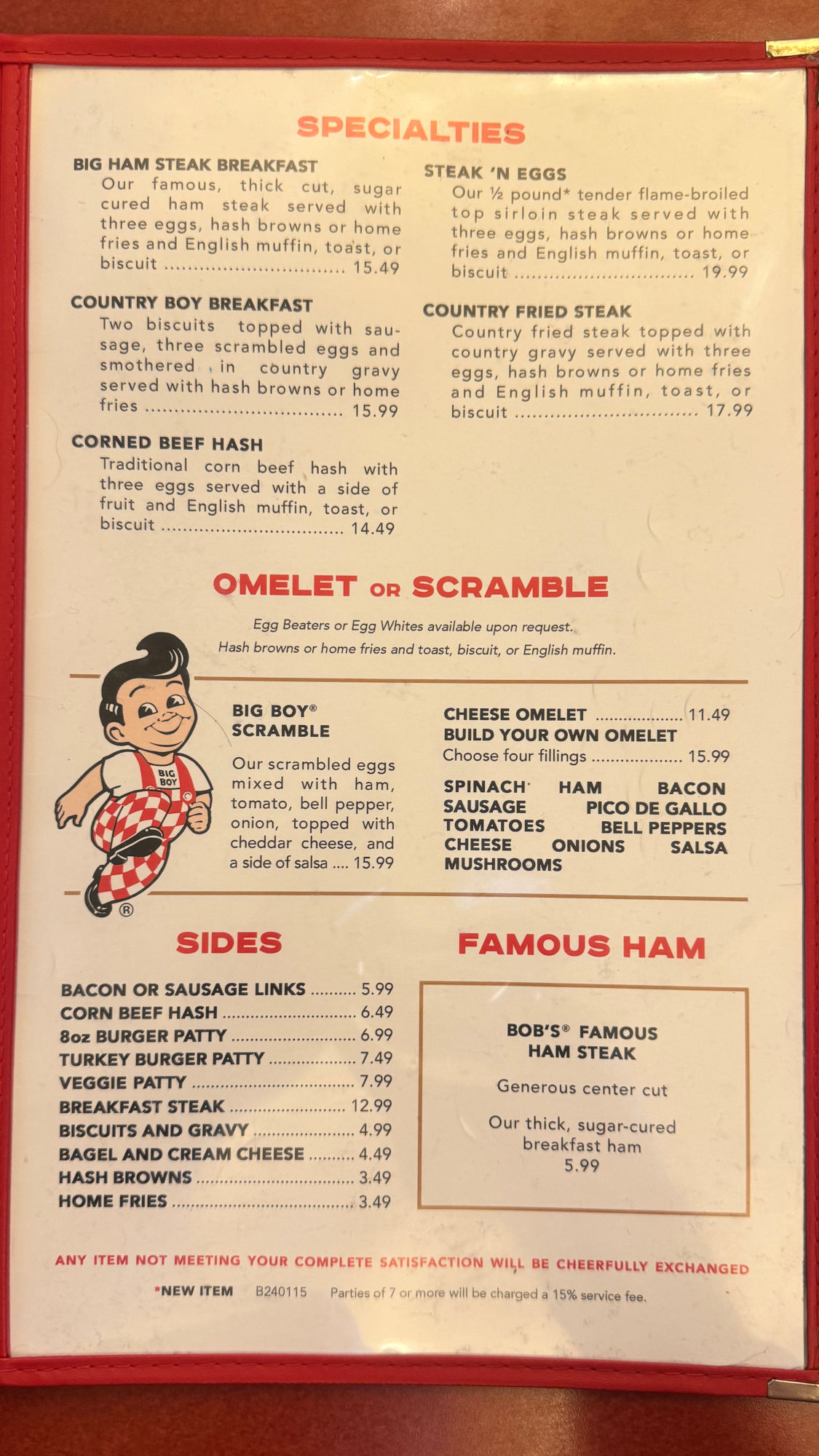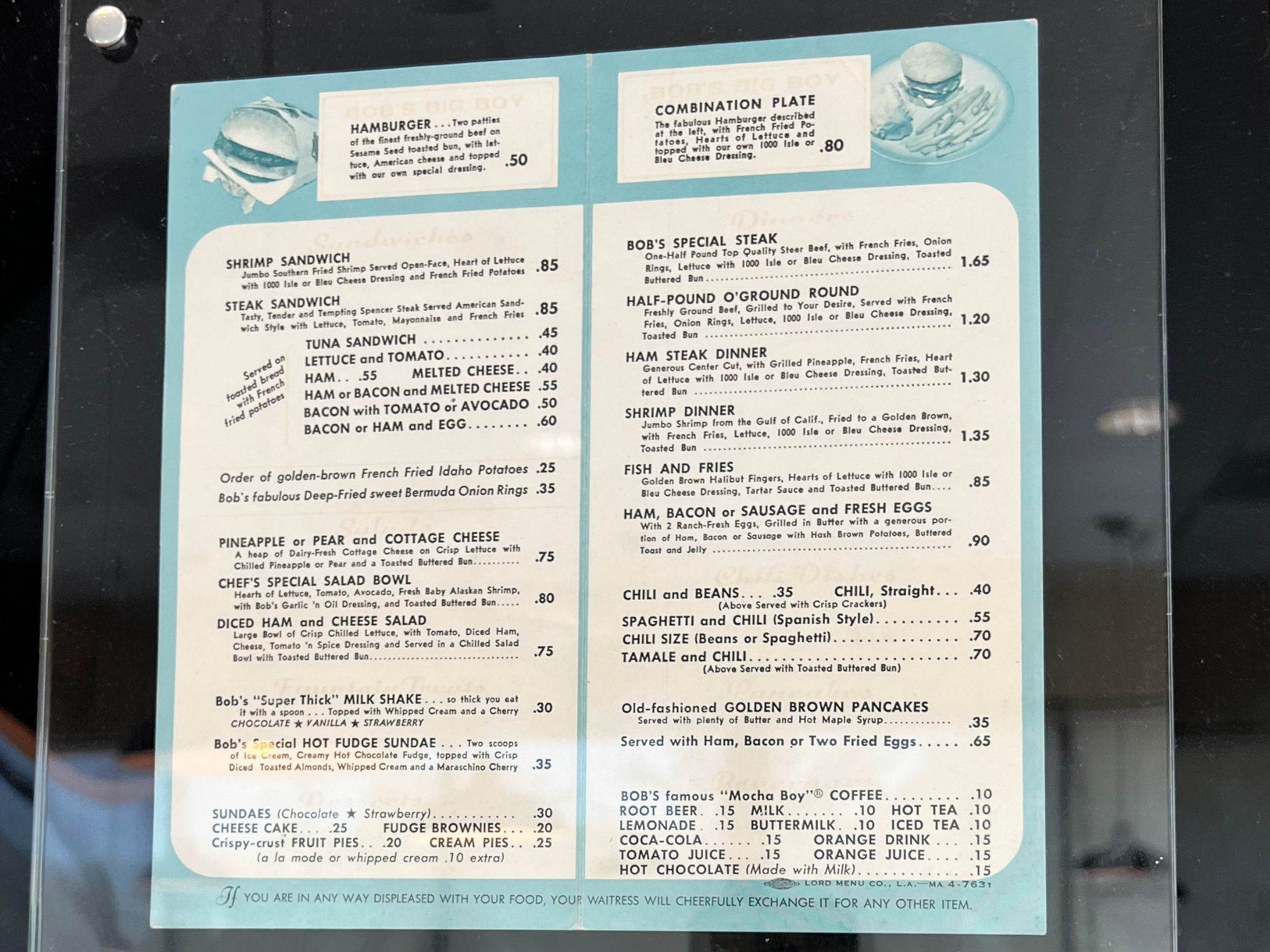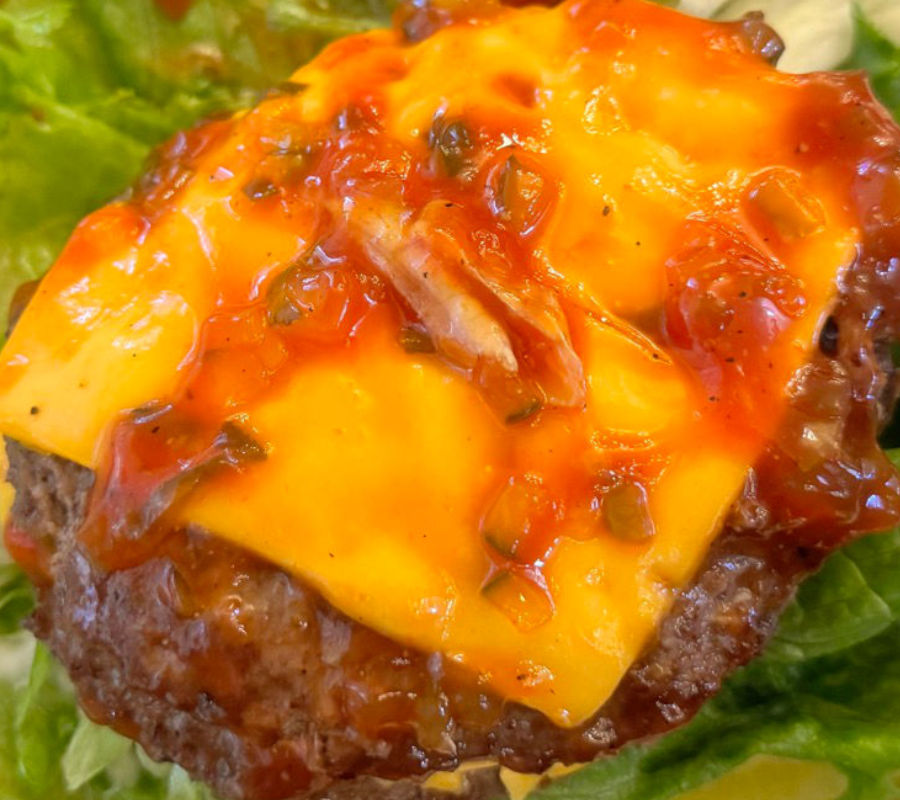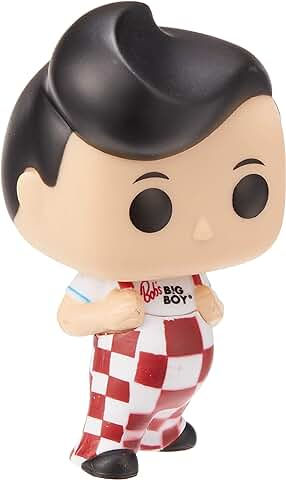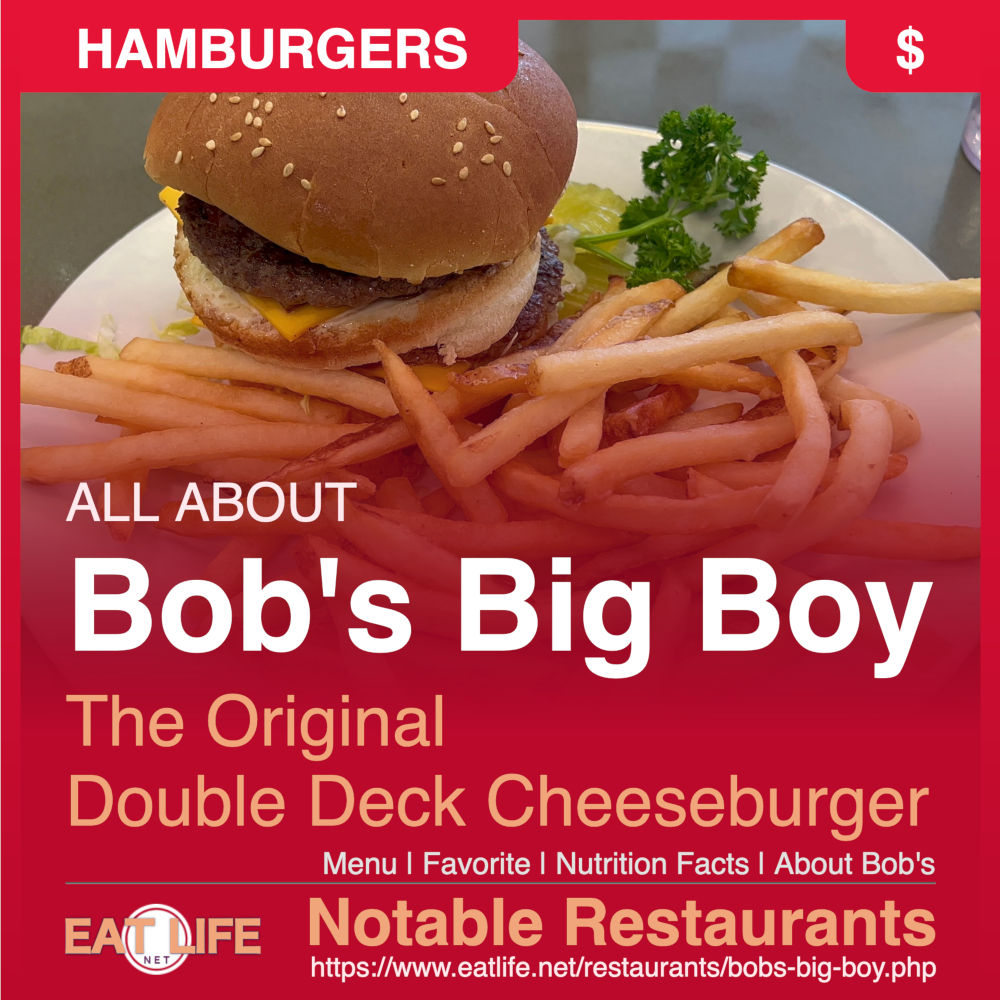He named it Bob's Pantry. One night in 1937, a regular customer requested something different for a change. Bob went to work, sliced a bun into three slices, added two hamburger patties and, voila, and the first double deck cheeseburger was born! One fan in particular was a chubby six year old boy in droopy overalls. Wian decided to name the better burger the Big Boy.



Original Big Boy Combo
The original double-deck hamburger
- Two "Never Frozen" Burgers
- Lettuce
- Cheese
- Mayo
- Their Special Red Relish




Classic Cobb Salad
- Mixed Greens
- Bacon
- Boiled Egg
- Blue Cheese Crumbles
- Tomato
- Turkey
- Avocado
- Blue Cheese Dressing
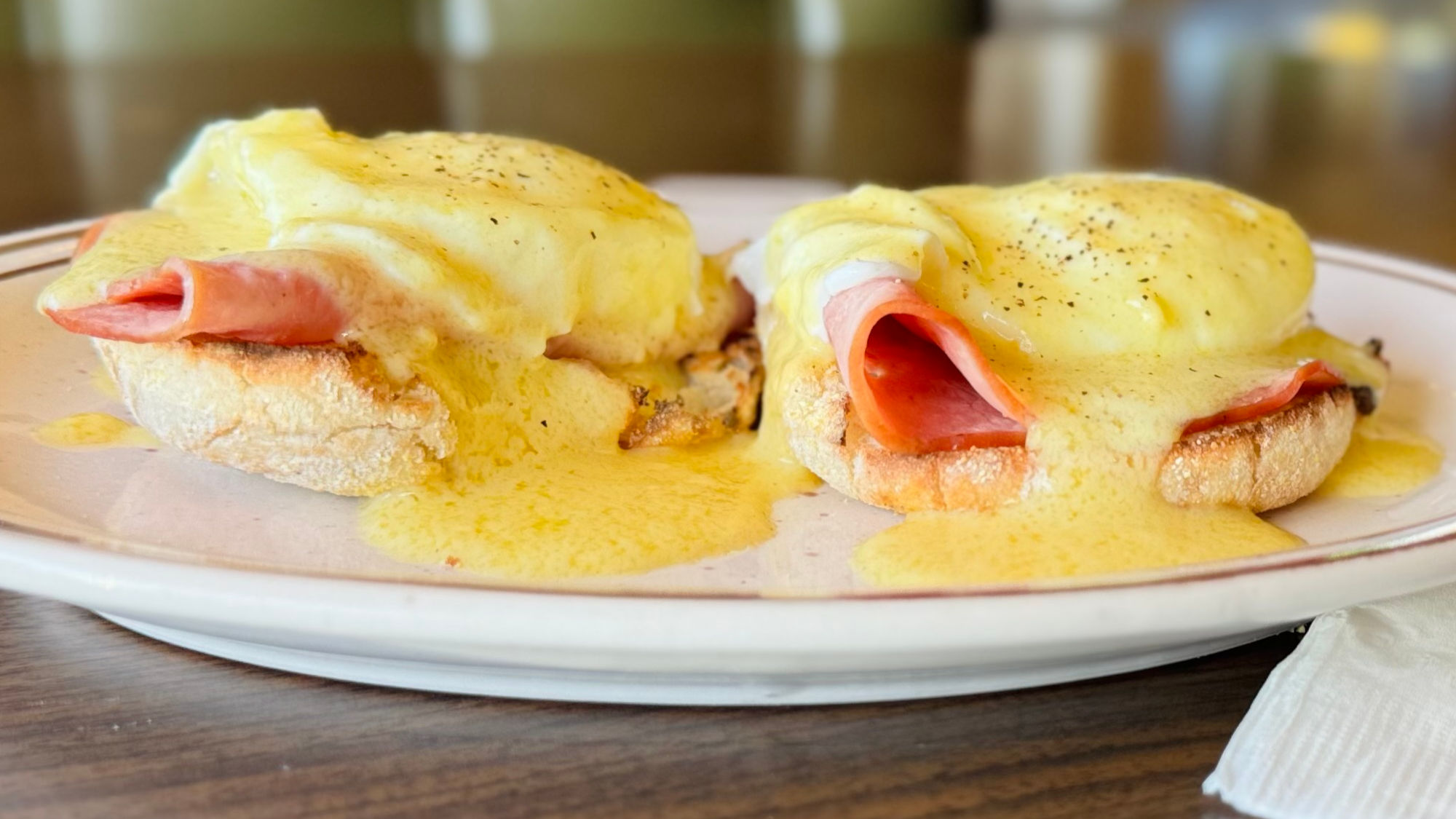
Eggs Benedict
- Toasted English Muffin
- Lean Ham
- Poached Eggs
- Hollandaise Sauce


Fruit Cup

BigboyBig Boy Continues
Now celebrating its 86th anniversary, Big Boy is proud of its history of serving delicious food, making memories, and giving back to your communities! Home to the original Big Boy burger, the Slim Jim, and the Classic Blockbuster Breakfast, Big Boy is meeting the future with new menu items, more ways to get your favorites, and staying dedicated you, the source of Big Boy's success.
BIG BOY: The History of Big Boy 1936 Where Our Story Began
In 1936, Bob Wian sold his prized DeSoto Roadster to purchase a hamburger stand in Glendale, California. He named it Bob's Pantry.1937 The First Double Decker Burger is Born!
One night in 1937, a regular customer requested something different for a change. Bob went to work, sliced a bun into three slices, added two hamburger patties and, voila, and the first double deck cheeseburger was born!The First Superfan, Richard Woodruff
Customers couldn't get enough of Bob's new creation. One fan in particular was a chubby six year old boy in droopy overalls. He would often help Bob sweep up in exchange for a free burger. In honor of his young friend, Wian decided to name the better burger the Big Boy.Bob's Big Boy Comes to Life
Another regular customer, a movie studio animator, sketched the now famous character on a napkin. The Big Boy burger craze that ensued prompted Bob to change the stand's name to Bob's Big Boy and to introduce the now-iconic Big Boy mascot.1949 A Landmark Is Born
The oldest remaining Bob's Big Boy in America was built in Burbank, CA in 1949 by local residents Scott MacDonald and Ward Albert. The restaurant was honored with the designation as a "Point of Historical Interest" by the state of California.Historical Design
Designed by renowned architect Wayne McAllister, the restaurant incorporates the 1940's transitional design of streamline modern style and the free-form 50's coffee shop architecture. The towering Bob's sign is the most prominent feature.1952 Our First Franchise
Brothers John, Louis, and Fred Elias were the first to formally apply to Bob Wian for a Big Boy franchise license. Their restaurant called the Dixie Drive-In in Hazel Park, MI became the first official Big Boy franchise.Gaining Traction
By 1964, the Elias Brothers had opened 100 restaurants bearing the Elias Brothers Big Boy name throughout Michigan and Ohio. The Elias Brothers purchased the Big Boy chain in 1987 and moved the headquarters to Warren, MI where they operated until 2000.1956 Adventures of the big Boy First Prints
The first edition of the Big Boy comic series was published, written by Stan Lee and produced by Timely Comics (later known as Marvel!) until 1961. Manny Stallman, followed by Bob Bindig, continued the series until 1996, making it one of the longest-running comics in American history.1965 Beatlemania Comes to Big Boy
The Beatles dined at Bob's Big Boy in Burbank, CA the summer of 1965. A plaque commemorates the event marks a corner booth by the window facing Riverside Drive. Many regulars and tourists from around the world request "the Beatles booth" every day.1967 Bob Sells Big Boy
Bob Wian sold the Big Boy chain to Marriott Corporation in 1967 for $7 million, that would be roughly $55 million today. After selling Big Boy, Bob Wian served as both vice president and president of Marriott's "Big Boy Restaurants of America" division, and later a board member, before retiring. Marriott later sold the franchise to the Elias brothers in 1987.1995 Big Boy Heats Up
Michael Mann filmed several scenes of his 1995 crime thriller Heat at Bob's Big Boy in Burbank, CA, catching shots of Dennis Haysbert, Robert De Niro, Tom Sizemore, and Val Kilmer.
[https://youtu.be/_3N9jfAsI7A]1997 Big Boy Takes Off
Big Boy makes a few memorable appearances in the 1997 comedy Austin Powers: International Man of Mystery, a James Bond spoof, directed by Jay Roach starring Mike Myers.
[https://youtu.be/_3N9jfAsI7A]2000 Cruising into the 21st
Robert Liggett, Jr. purchased the Big Boy chain in 2000. He served as Chairman from 2000 to 2018. In 2018, he sold the company to a group of Michigan investors, who renamed the company Big Boy Restaurant Group.Here at Big Boy, we're dedicated to thinking BIG! Because we want you to think Big Boy (for breakfast, lunch, or dinner)!
Roadside ArchitectureBig Boy Restaurants
The history of Bob's Big Boy and Big Boy restaurants can be traced back to 1936 when Bob Wian bought a local Glendale restaurant and named it Bob's Pantry. Wian supposedly originated the double-decker hamburger and came up with the Big Boy character. Bob's Big Boy became a California chain and began franchising in the 1940s. Unlike other chains like McDonald's, Wian did not require uniformity. Franchise owners were free to name their restaurants whatever they wanted. The restaurants were known as Frisch's Big Boy and Manners Big Boy in Ohio. Frisch's and Manners Big Boy restaurants used the same skinnier, running boy as their mascot. In the late 1970s, Manners locations became Bob's Big Boy restaurants.The restaurants were known as Elias Brothers Big Boy restaurants in Michigan, Northeastern Ohio, and Ontario. The Elias brothers had their own restaurants before becoming a Big Boy franchisee in 1952. The company kept the Elias name and added the Big Boy character and "Home of the Big Boy" to their signs and advertising. In 1987, they acquired the Big Boy chain's franchise rights from Marriott Corp. Big Boy is now Michigan-based and has about 450 restaurants in California, Arizona, Hawaii, North Dakota, Illinois, Michigan, Ohio and North Carolina.

Roadside ArchitectureFrisch's Restaurants
Frisch's was founded in Cincinnati in 1923. Dave Frisch arranged a franchise with Bob Wian around 1949. Frisch's used tartar sauce rather than 1,000 Island dressing on their burgers. Frisch's bought the rights to the Big Boy name in late 2000 after the Elias Bros. bankruptcy. There are now 88 company-owned Frisch's and 26 franchise units, all using the Frisch's Big Boy name. They are located in Ohio, Indiana and Kentucky.
Weird CaliforniaBob's Big Boy started in 1936 when Bob Wian purchased a ten stool hamburger stand called "The Pantry" in Glendale. The food stand cost $300 which Wian acquired by selling his car, a DeSoto Roadster. The small restaurant was renamed "Bob's Pantry". Supposedly six months later he invented the first double-decker burger, or a burger with two patties. One of his patrons was a six year old boy named Richard Woodruff, who loved the double-decker burger so much, that Wian named the new burger "Big Boy" after his nickname for Woodruff. Eventually the name of the restaurant was changed and a mascot, with some resemblance to Woodruff was created.Today, although there are a few dozen Bob's Big Boy restaurants and statues in Michigan, there are only five remaining active Bob's Big Boy restaurants in California! There are even more buildings in the state that use to be Bob's Big Boys. The five remaining restaurants can be found in: Burbank, Calimesa, Downey, Norco, and Northridge. All have at least one Big Boy statue, and several even have two or more. In addition to these five locations, several more Bob's Big Boy statues still exist in California at non Big Boy Restaurant locations. The mascot of Bob is still very well known throughout California, so much so that Dr. Evil in the movie Austin Powers even disguises his spaceship as a giant Bob statue.
Here are the locations of the five remaining Bob's Big Boy Restaurants in California:
- 4211 Riverside Drive, Burbank, California 91505
- 540 Sandalwood Drive, Calimesa, California 92320
- 7447 Firestone Boulevard, Downey, California 90241
- 3521 Hamner Avenue, Norco, California 92860
- 8876 Corbin Avenue, Northridge, California 91324
Here is a list of the locations for the other Bob's Big Boy statues in California:
- Noodle World: 700 W Valley Boulevard, Alhambra, California 91803
- 777 Tractor Sales: 3850 El Camino Real, Atascadero, California 93422 (looks missing now)
- Burbank Historical Society: 115 North Lomita Street, Burbank, California 91506
- Brookside Equestrian Park: 11120 Bradley Ranch Road, Elk Grove, California 95624
- Deer Park Winery and Auto Museum: 29013 Champagne Boulevard, Escondido, California 92026
- Bell Plastics: 2020 National Avenue, Hayward, California 94545
- Naples Canal, Long Beach, California
- Malibu Wine Safaris: 32111 Mulholland Highway, Malibu, California 90265
- Rocket Fizz: 699 Higuera Street, San Luis Obispo, California 93401 (Bob is now missing)
- Valley Reics: 7900 Balboa Blvd. Van Nuys, CA 91406
- Reiff's Gas Station: Woodland, California
- Bob's Arm Used as a Mailbox: 10612 Baird Avenue, Los Angeles, California 91326
East Coast vs West Coast Big Boys
There are a few dozen Bob's Big Boy Restaurants in Michigan, which is now home to the company's headquarters. Additionally back East, one can find Frisch's Big Boy, a former franchisee who now owns the trademarks for Big Boy in Indiana, Kentucky, and parts of Ohio and Tennessee. Dave Frisch had a franchise agreement with Bob Wian until 2000, where he could operate in several states for the low price of $1 a year. The agreement came to an end in 2001 after the Big Boy restaurants were purchased post bankruptcy. When Frisch's separated from Big Boy Restaurants, they were able to maintain their right to the trademark in their areas. Although some of the statues at these restaurants look the same or similar to the Bob statues on the west coast, many also have a different feel. Commonly referred to as East Coast Big Boy statues, Frisch's Big Boy is a little thinner, holds the hamburger differently, and is in a different pose. A new statue has slowly been appearing, looking a bit more like the West Coast Big Boy, but having striped overalls and different shoes. He's also holding his burger up with his left hand.Japan has 274 Big Boy locations, and at least some have the same statue as the West Coast chain, although he's not holding what looks like a burger! Additionally, I hear the menu is rather different in Japan.
Bob's Pantry in Glendale, est. 1936: "Home of the Big Boy Burgers."
Yes, that's right, 85 years ago, and more than three decades before Dr. Evil left the Earth in a rocketship made out of its mascot, Bob's Big Boy was a 10-stool hamburger stand at 900 E Colorado St in Glendale, opened for $350 by 23-year-old former busboy Bob Wian who raised the money by selling his car.

In the early months of 1937, about six months into operation, one of Wian's friends walked into the joint and reportedly asked for a different kind of hamburger, so Wian jokingly just added a second patty with a bun in between, inventing the double-decker burger which, to his surprise, suddenly took off.

According to legend, Wian named the sandwich the Big Boy Burger after six-year-old customer Richard Woodruff who used to come in on his own and stay at the counter eating multiple burgers until his grandmother would come in and drag him out of the place. Woodruff would also become the restaurant's original mascot, after another regular customer, Warner Bros. animation artist Ben Washam, doodled the kid's caricature on a napkin one day while eating lunch. Wian saw it and asked to buy it, but Washam gave it to him for free.
In the 85 years that followed, the company has had its ups and downs, nearly closing completely during the second world war, then building back up and expanding to eight locations and then to thirty, with each location offering in-house comic books about the adventures of the Big Boy character (...it ran for 39 years, printing 466 issues). In the late 1960s, Wian sold the company to Marriott and it quickly expanded to 580 locations, and then later to more than a thousand. Today, following a bankruptcy and several changes in ownership, the restaurant is down to 69 locations in the US, with five of those in Southern California (Toluca Lake / Burbank, Northridge, Downey, Norco, and Calimesa), as well as 274 in Japan, and 2 in Thailand. That's Wian in the second photo.
Find a GraveRichard Lee "Big Boy" Woodruff
Bob's Big Boy photograph of the model which became the symbol used by Bob's Restaurants for over 60 years!
His name was Richard Woodruff and he lived down the street from the original Bob's Pantry located in Glendale California.
The original of this picture was kept in Richard's wallet and was signed on the back by Bob Wain, who started Bob's in the 1930's. Richard was a fat little boy who hung around the small Bob's Panty on Colorado Street. On one occasion little Richard asked if he could have a hamburger with two pieces of meat on it. Now known as the first "double-decker" hamburger!
Ben Washam, the well-known Warner Bros. animation artist designed the famous "Fat-Boy" logo in the 1940's after little Richard Woodruff. This photo shows a little older and bigger Richard posing in front of the original Bob's Pantry located on Colorado Street in Glendale holding the now famous "double-decker" hamburger.
WIKIPEDIABig Boy Restaurant Group, LLC
American casual dining restaurant chain headquartered in Southfield, Michigan. The Big Boy name, design aesthetic, and menu were previously licensed to a number of regional franchisees.Big Boy began as Bob's Pantry in 1936 by Bob Wian in Glendale, California. The restaurants became known as "Bob's", "Bob's Drive-Ins", "Bob's, Home of the Big Boy Hamburger", and (commonly as) Bob's Big Boy. It became a local chain under that name and nationally under the Big Boy name, franchised by Robert C. Wian Enterprises; Wian only required franchisees to use "Big Boy" and not include his name "Bob's".
Marriott Corporation bought Big Boy in 1967. One of the larger franchise operators, Elias Brothers, purchased the chain from Marriott in 1987, moved the headquarters of the company to Warren, Michigan, and operated it until bankruptcy was declared in 2000. During the bankruptcy, the chain was sold to investor Robert Liggett, Jr., who took over as chairman, renamed the company Big Boy Restaurants International and maintained the headquarters in Warren.
In 2018, Big Boy was sold to a group of Michigan investors and renamed Big Boy Restaurant Group, with David Crawford as chairman, CEO, and co-owner of the new company. The company is the operator or franchisor for 66 Big Boy restaurants in the United States and two in Thailand. In January 2020, Tamer Afr replaced Crawford as chairman, CEO, and co-owner.
Immediately after Liggett's purchase, Big Boy Restaurants International - then known as Liggett Restaurant Enterprises - negotiated an agreement with the other large franchise operator, Frisch's Restaurants. The Big Boy trademarks in Kentucky, Indiana, and most of Ohio and Tennessee transferred to Frisch's ownership; all other Frisch's territories transferred to Liggett. Thus Frisch's is no longer a franchisee, but Big Boy Restaurant Group and Frisch's are now independent co-registrants of the Big Boy name and trademark. Frisch's operates 90 Big Boy restaurants in the United States, which 10 are franchised.
Big Boy Japan, also independent of Big Boy Restaurant Group, operates 274 restaurants in Japan.
The Big Boy Mascot
The chain is best known for its trademark chubby boy with a pompadour hairstyle wearing red-and-white checkered overalls holding a Big Boy sandwich (double-decker cheeseburger). The inspiration for Big Boy's name, as well as the model for its mascot, was Richard Woodruff of Glendale, California. When he was six years old, Woodruff walked into the diner Bob's Pantry as Bob Wian was attempting to name his new hamburger. Wian said, "Hello, Big Boy" to Woodruff, and the name stuck. Warner Bros. animation artist Ben Washam sketched Richard's caricature, which became the character seen on the company trademark.In 1955, Bob Wian hired Manfred Bernhard, son of graphic designer Lucian Bernhard, to create a new public image for Big Boy. Bernhard was not impressed with Washam's mascot, saying it was sloppy and had a moronic expression. The "West Coast Big Boy" mascot was revised, fiberglass statues molded, schemes created for menus and building designs, and a comic book for children launched.
In 1951, Bob Wian's original franchisee Dave Frisch developed a slightly different Big Boy character. He was slimmer, wore a side cap, saddle shoes and striped overalls. Having reddish or blonde hair, he was portrayed in a running pose. Known as the "East Coast Big Boy", he was copyrighted by Frisch's and used for statues and comic books for Frisch's, and its subfranchisees Manners and Azar's. Before 1954, Parkette (Shoney's) used both versions, though never together. Since 1956, the Wian "West Coast Big Boy" design was used exclusively by all franchisees other than Frisch's, Manners and Azar's. In the late 1960s, both characters were redrawn to appear similar, incorporating the checkered outfit, pompadour and hamburger above the raised arm from the West Coast design, and the running pose and direction of the East Coast design. In the 1980s, the hamburger was removed from the West Coast design; representing a de-emphasis of the hamburger in North American Big Boy restaurants, it also accommodated the Japanese Big Boy restaurants, which do not serve hamburgers on a bun.
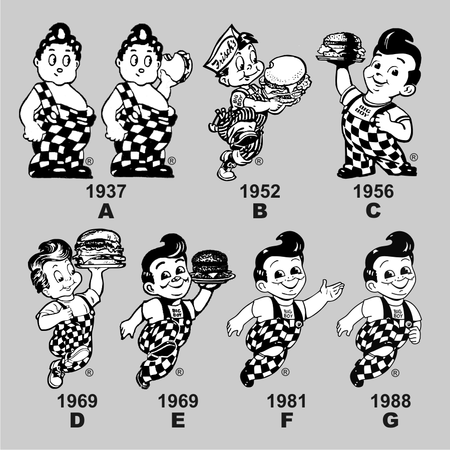
The Evolution of the Big Boy Mascot
- 1937 A The first Big Boy (left) was derived from a sketch by Warner Brothers animation artist Bennie Washam in 1937. A frequent customer, Washam doodled the character on a napkin for Bob Wian for a free lunch. The logo, redrawn holding a hamburger (right), was typically used by Wian and several early franchisees: Parkette (Shoney's), Elias Brothers and Frejlach's. The orientation was also reversed.
- 1952 B Wian's first franchisee, David Frisch, developed his own Big Boy character. Dated 1952, the design was copyrighted in 1951 and became known as the East Coast Big Boy. He was the model for fiberglass statues used by Frisch's, and subfranchises Azar's and Manners. This Big Boy varied between blond and reddish blond hair. Unlike West Coast designs (A) and (C), he held the hamburger in both hands and was always running to his left.
- 1956 C This scheme introduced the modern Big Boy character and is the model for the iconic fiberglass statues. It replaced Wian's original figure (A), and was actually seen in 1955 Shoney's advertisements. Typically drawn with the hamburger atop his right arm, occasionally the hamburger was raised atop his left arm. Shown is a common version of the several renderings used. By 2009, a new styled version is sometimes being used again.
- 1969 D Revised East Coast Big Boy.
- 1969 E Revised West Coast Big Boy.
The differences between the East and West Coast designs, including the statues, created confusion along the Ohio-Michigan border where Frisch's and Elias Brothers operated. This motivated a common Big Boy mark, derived with elements of both predecessors, (B) and (C). He retained the look of the West Coast figure (C) but assumed the running pose and orientation of the East Coast figure (B). Nonetheless, similar West and East Coast versions were realized, maintaining the facial style of the previous marks, respectively. Frisch's continued to use (D) through 2016.- 1981 F To emphasize a full menu the hamburger was removed from the West Coast design.
- 1988 G After buying Big Boy, Elias Brothers lowered the left arm completely.
The Big Boy Hamburger
The novel hamburger started as a joke. In February 1937, some local big band musicians, who were regular customers of Bob's Pantry, visited the restaurant. When ordering, bass player Stewie Strange asked, "How about something different, something special?". Bob Wian improvised, creating the first (then unnamed) Big Boy, intending the thing "look ridiculous, like a leaning tower". Demand for "the special" soared but Wian sought a "snappy" name, which became Big Boy. In 1938, the Big Boy hamburger cost 15¢. Several slogans were used from the 1950s through the 1970s to promote the Big Boy hamburger, such as, "A Meal in One on a Double-Deck Bun" and "Twice as Big, Twice as Good". On menus from that period, it was called, "...the Nationally Famous, Original Double-Deck Hamburger...".
The Signature Big Boy Hamburger is the original double deck hamburger.The Big Boy hamburger inspired and was the model for other double deck hamburgers. This includes McDonald's Big Mac, Burger Chef's Big Shef and Burger King's Big King.
BOB'S BIG BOYThe Big Boy
Two thin beef patties placed on a three-layer bun with lettuce, a single slice of American cheese, and either mayonnaise and red relish (a combination of sweet pickle relish, ketchup, and chili sauce), Big Boy special sauce (often called thousand island dressing) or (at Frisch's, Manners and Azar's) tartar sauce on one or each slice of bun. (Regardless, the Big Boy condiment used was often simply referred to as "special sauce" on menus chainwide.) Wian used a sesame seed bun while Frisch's used a plain bun and included pickles.The Big Boy hamburger originally called for a quarter pound (4 ounces) of fresh ground beef, but later, franchisees were permitted to use frozen beef patties, and the minimum content reduced to a fifth of a pound to offset increasing food costs. Other specifications were exacting, such as the bun's bottom section being 1 1/2 inches high and the center section 3/4 inches, and 1 1/2 ounces of shredded lettuce used.
Bob's Big Boy Franchisees Logos
Franchisees were once required to use their own name with the Big Boy name and character. Some changed logos periodically and these show designs used while a Big Boy affiliate, most dating from the mid 1950s to the mid 1960s. Eat'n Park, Shoney's and JB's are no longer affiliated with Big Boy. Logos for Adler's, Arnold's, Bud's and Chez Chap were not available to the artist.











